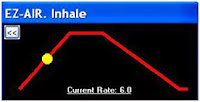Every year at this time the media features articles about holidays and stress. This can indeed be a hectic time of year, but it doesn’t have to be stress filled. The Mayo Clinic’s website offers a list of coping strategies, including one that focuses on breathing:
“Take a breather. Make some time for yourself. Spending just 15 minutes alone, without distractions, may refresh you enough to handle everything you need to do. Take a walk at night and stargaze. Listen to soothing music. Find something that reduces stress by clearing your mind, slowing your breathing and restoring inner calm.” Click here for full article.
As we approach the holidays, I thought it would be a good time to remind all the followers of this blog about the BFE’s EZ-AIR PLUS software program. EZ-AIR PLUS is a software program published by the BFE to help you breathe better when sitting at your computer. It allows you to place a thin bargraph or linegraph anywhere on your computer screen to help you pace your inhalation and exhalation. You can let it run continuously on screen (with or without sound) or you can schedule "breaks" throughout your day to regulate breathing.
 |
The Physiology of Breathing
Breathing is a natural process which occurs without conscious control. Babies and young children breathe effortlessly. Most of the movement associated with their breathing occurs primarily in the lower abdominal area. As they exhale, their abdomen (stomach) goes in slightly. When they inhale, they abdomen expand outward and to the sides. Most adults, however, no longer breathe in this healthy pattern. Instead, they hold their stomach rigid or slack and use a significant amount of upper body muscular activity to inhale.
The major muscle involved in proper breathing is called the diaphragm. This is a dome shaped muscle located beneath the ribs and above the stomach. In order to inhale, the diaphragm tightens and flattens. This activity displaces the liquid contents of the abdomen and thereby creates a larger space in the chest. As this space is created, the pressure in the atmosphere exceeds the pressure in the chest and air flows in to balance these pressures out.
To exhale, the diaphragm must relax and be raised upward, compressing the air in the chest and allowing the air to be expired. Thus, inhalation requires that the abdominal area relax and expand, while exhalation requires the abdominal area to decrease in diameter. The chest and shoulders should stay relaxed throughout the breathing cycle.
From the manual “Breathing for Health With Biofeedback” by Dr. Erik Peper
EZ-AIR PLUS. It is a great way to relax, reduce stress and a reminder to do something good for ourselves during this busy time of year!



